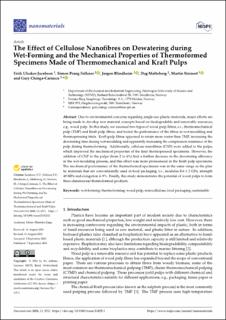The Effect of Cellulose Nanofibres on Dewatering during Wet-Forming and the Mechanical Properties of Thermoformed Specimens Made of Thermomechanical and Kraft Pulps
| dc.contributor.author | Jacobsen, Eirik Ulsaker | |
| dc.contributor.author | Følkner, Simen Prang | |
| dc.contributor.author | Blindheim, Jørgen | |
| dc.contributor.author | Molteberg, Dag Einar | |
| dc.contributor.author | Steinert, Martin | |
| dc.contributor.author | Chinga Carrasco, Gary | |
| dc.date.accessioned | 2024-02-29T09:27:25Z | |
| dc.date.available | 2024-02-29T09:27:25Z | |
| dc.date.created | 2023-10-20T13:18:11Z | |
| dc.date.issued | 2023 | |
| dc.identifier.citation | Nanomaterials. 2023, 13 (18), . | en_US |
| dc.identifier.issn | 2079-4991 | |
| dc.identifier.uri | https://hdl.handle.net/11250/3120433 | |
| dc.description.abstract | Due to environmental concerns regarding single-use plastic materials, major efforts are being made to develop new material concepts based on biodegradable and renewable resources, e.g., wood pulp. In this study, we assessed two types of wood pulp fibres, i.e., thermomechanical pulp (TMP) and Kraft pulp fibres, and tested the performance of the fibres in wet-moulding and thermopressing trials. Kraft pulp fibres appeared to retain more water than TMP, increasing the dewatering time during wet-moulding and apparently increasing the compression resistance of the pulp during thermoforming. Additionally, cellulose nanofibres (CNF) were added to the pulps, which improved the mechanical properties of the final thermopressed specimens. However, the addition of CNF to the pulps (from 2 to 6%) had a further decrease in the dewatering efficiency in the wet-moulding process, and this effect was more pronounced in the Kraft pulp specimens. The mechanical performance of the thermoformed specimens was in the same range as the plastic materials that are conventionally used in food packaging, i.e., modulus 0.6–1.2 GPa, strength 49 MPa and elongation 6–9%. Finally, this study demonstrates the potential of wood pulps to form three-dimensional thermoformed products. | en_US |
| dc.language.iso | eng | en_US |
| dc.publisher | MDPI | en_US |
| dc.rights | Navngivelse 4.0 Internasjonal | * |
| dc.rights.uri | http://creativecommons.org/licenses/by/4.0/deed.no | * |
| dc.title | The Effect of Cellulose Nanofibres on Dewatering during Wet-Forming and the Mechanical Properties of Thermoformed Specimens Made of Thermomechanical and Kraft Pulps | en_US |
| dc.title.alternative | The Effect of Cellulose Nanofibres on Dewatering during Wet-Forming and the Mechanical Properties of Thermoformed Specimens Made of Thermomechanical and Kraft Pulps | en_US |
| dc.type | Journal article | en_US |
| dc.type | Peer reviewed | en_US |
| dc.description.version | publishedVersion | en_US |
| dc.source.volume | 13 | en_US |
| dc.source.journal | Nanomaterials | en_US |
| dc.source.issue | 18 | en_US |
| dc.identifier.doi | 10.3390/nano13182511 | |
| dc.identifier.cristin | 2186783 | |
| cristin.ispublished | true | |
| cristin.fulltext | original | |
| cristin.qualitycode | 1 |

